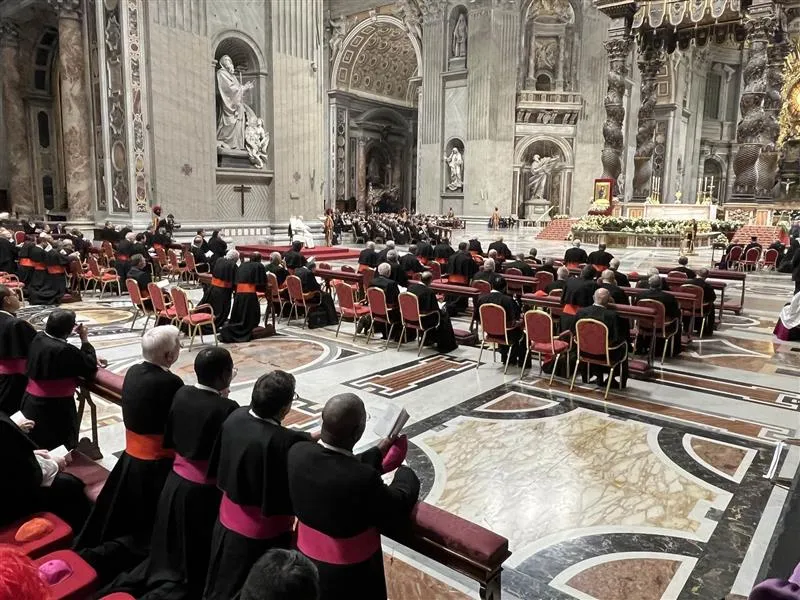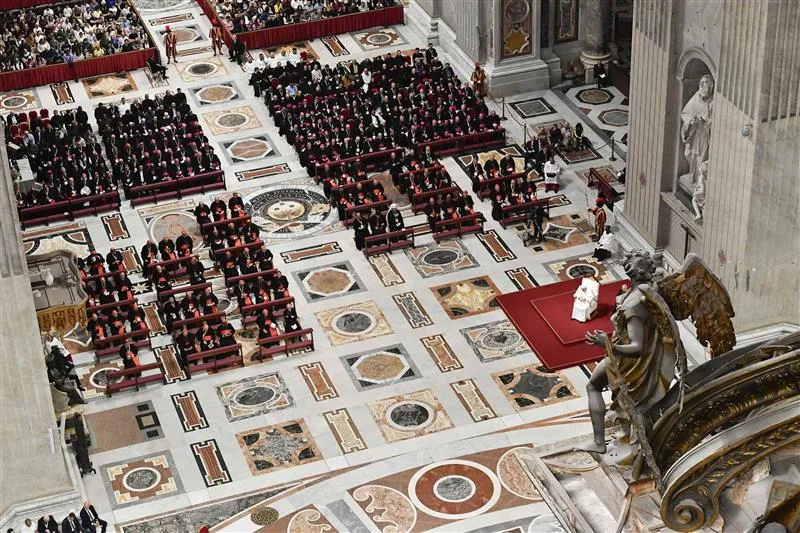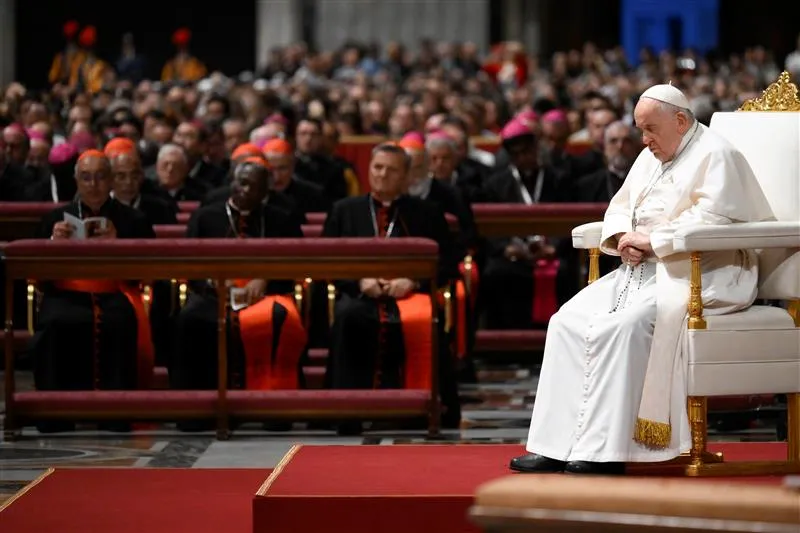
Loreto, Italy, Mar 27, 2019 / 02:23 pm (CNA).- The Vatican press office declined to comment after a video went viral this week showing the pope refusing to allow pilgrims to kiss his ring as they greeted him.
The clip was taken from video footage of pilgrims meeting the pope after his celebration of Mass in the Holy House in Loreto, Italy, March 25.
In the clip, which is just over a minute in length, Pope Francis appears to pull his hand away each time a person approaches to greet him and attempts to kneel and to kiss his hand or ring.
A more full video by Vatican Media showed that the pope was receiving people for much longer than the first clip presented – around 13 minutes in total – and that he had allowed some people to kiss his ring, without visible protest, during the earlier part of the greeting line.
The custom of kissing the ring of the pope or a bishop has been a gesture of respect in the Church for longer than can be remembered, but likely started in the late Middle Ages, according to Fr. Roberto Regoli, who teaches contemporary Church history at the Pontifical Gregorian University.
He said kissing the pope’s ring “expresses devotion not to the person of the pope, but to whom and what he represents: the successor of the fisherman of Galilee” and “indicates fidelity and love for the Church.”
While the commonly-used Italian term for the greeting is “baciamano,” literally meaning “hand kiss,” Regoli said that is misleading, and properly speaking, it is the papal Ring of the Fisherman which is kissed.
Pope Francis did not appear to be wearing that particular ring in Loreto March 25. Outside of papal ceremonies, Francis is typically seen wearing only his episcopal ring.
The custom of kissing the Fisherman’s Ring, while it begun much earlier, was systematized in the 15th century in a text on pontifical ceremonies, Regoli said.
It is customary to kiss the ring of a bishop, out of reverence for his dignity as a successor of the apostles, and the hand of a priest, as it has been anointed with chrism to consecrate the Body of Christ.
The prayer traditionally said by a bishop before vesting with his ring for pontifical Mass is: “The digits of my heart and my body, O Lord, adorn with virtue, and with the sanctification of the sevenfold Spirit surround them.”
The Fisherman’s Ring is one of several rings typically worn by the Roman pontiff. The ring takes its name from its image of St. Peter as a fisherman, which became the standard design around the mid-15th century.
The first record of the ring’s use was on two letters of Clement IV in 1265 and 1266. It was used as a wax seal in private letters in place of the official lead seal used for solemn papal documents.
In 1842, use of the ring and wax seal were replaced by a stamp, but each pope still receives a unique Ring of the Fisherman at the start of his papacy, which is then destroyed soon after his death.
In the early 20th century, St. Pius X connected a partial indulgence to kissing the Fisherman’s Ring.
The custom started to change with St. Paul VI in the last decades of the 20th century, when he eliminated other forms of showing papal obedience and subservience, such as kissing the pope’s foot, shoulder, and cheek, Regoli explained.
Fr. Johannes Grohe, a professor of Church history at the Pontifical University of the Holy Cross, told CNA that to greet a bishop with a kiss of his ring is a sign of his episcopal dignity and is still “quite widespread.”
In the past, “this gesture was accompanied by a bow of the head or a knee bend,” he said, and while “kissing the episcopal ring in an official greeting is still in use, to bend the knee not so much.”
Pope Francis, he continued, “seems to be against it. Sometimes he allows it, sometimes he denies it (even in an apparent way).”
Regoli said that with Francis “there is a further sensibility, different from his predecessors, so we tend to further simplify the ceremonial by omitting the greeting of genuflection towards him.”
According to Grohe, “there is in [Pope Francis] an attitude contrary to everything that could recall court customs,” and “certainly,” he added, “some customs in ceremonies and pontifical audiences have a long tradition and therefore also have the form of other time periods.”
If you value the news and views Catholic World Report provides, please consider donating to support our efforts. Your contribution will help us continue to make CWR available to all readers worldwide for free, without a subscription. Thank you for your generosity!
Click here for more information on donating to CWR. Click here to sign up for our newsletter.










There are those like Rosica who see Bergoglio as beyond Tradition and Scripture, a kind of “never before” Jesuit Catholic Ubermensch/Superhero. Not me. I am also not a fan of “crazy wisdom.”
There is no end to the amount of required damage control and necessarily misleading explanatory statements, the required lies.
Intimations of “the lawless one.”
In regards to the kissing of the ring of the pope! The hands of a priest are the hands of Jesus. Every priest who is holy knows that. People kiss the ring, because of the hands that consecrate the Eucharist Who IS Jesus in Body, Blood, Soul and Divinity. This pope as a Catholic should know that, but he doesn’t, so he desecrates all that he is, and especially sacred hands. In mind, body and spirit, his soul is so dark, and any priest who follows this pope is as dark as he is! No more sacred hands for priests…
The priests must follow the pope because he is the successor to Saint Peter the Apostle. Anyone who is not in communion with the Bishop of Rome is not in full communion with Christ’s Church.
He is NOT Jesus. He is a mere man just like any other man. To kiss this ring is found no place in the Bible. For anyone to think a man is Jesus on earth does not know Jesus Christ nor His teachings.
I don’t what you are implying but I would like to remind you that Pope Francis is the successor to Saint Peter the Apostle and deserves our respect.
He seems to be mocking the faith of the followers who do venerate relics (traditional Catholics). He could have avoided scandal by making it known that he didn’t want veneration of the Pope, or the Pope’s ring, and his aides could have guided people ahead of time not to bow down and kiss the hand/ring of the Pope as a point of respect to the devote. That kind of thoughtfulness on the part of the Pope and his aides would have spared the world this mockery. What is seen by the viewers of this is Pope engaging rejection of the faith of the followers of Christ, and shows a lack of reverence and respect to the followers of Christ. It also appears that he enjoys this cruelty, which is appalling! People traveled from various corners of the earth to be rebuffed and humiliated? Clearly he is not Christ, and one has to scratch one’s head if he is the representative of Christ and a very bad Pope. Perhaps Catholics do engage in a bit of idolatry by expecting anything that resembles respect for the faith and the faithful from this Pope. Something is terrible wrong here.
Considering the fact that he allowed people earlier in line to kiss his hand, I would say he probably just wanted to hurry the line along. I am not saying that that was the kindest, most intelligent thin to do, but as the successor to Saint Peter the Apostle, the Holy Father is probably very busy. I am not saying that Pope Francis did the right thing in this situation, but I think some people are blowing this out of proportion, which also doesn’t help the way people perceive the Church.
I can’t wait till his pontificate is over, we need a Pope , like of old
Francis GO
You said “we need a pope,” we do have a pope, Pope Francis. If you meant we need a pope of old, you should have said, we need a pope of old. Where you put the punctuation like commas matters because people can easily misunderstand what you are saying especially.
I think we should give Bergoglio the benefit of the doubt. Perhaps he is conscience-stricken. Maybe by declining to allow believers to kiss the papal ring, he’s demonstrating that his papacy is somehow not legitimate, that he’s not really the pope.
Pope Francis is the legitimate pope, and anyone who is not in communion with him is not in full communion with the Catholic Church.